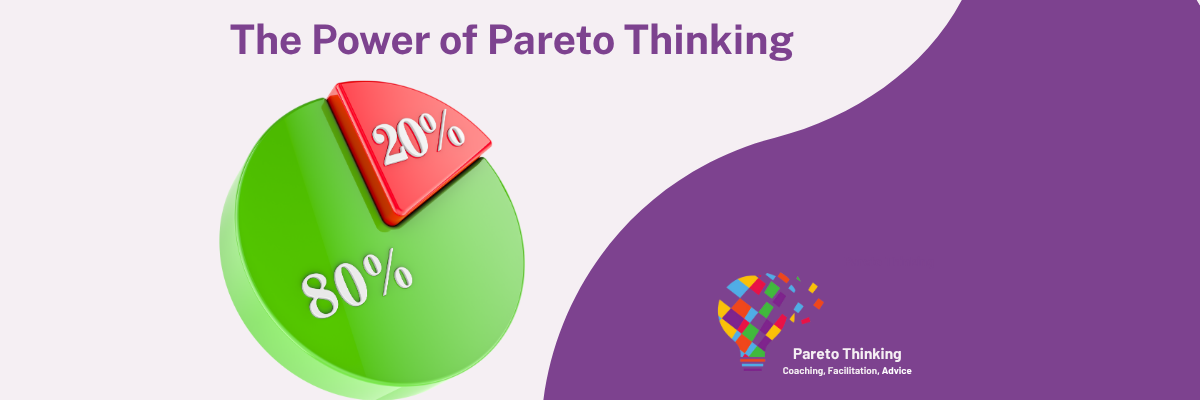When I set up my own business in 2023, I chose to name it Pareto Thinking, inspired by Vilfredo Pareto’s eponymous principle.
The Pareto Principle is a powerful concept that’s shaped my approach to leadership and life. Which probably warrants some explanation….
Vilfredo Pareto, was an Italian economist who noticed that 20% of the pea plants in his garden produced 80% of the peas. He went on to observe that 80% of Italy’s wealth was owned by 20% of the population. Some time later, management consultant Joseph Juran developed these ideas and posited that 80% of effects stem from 20% of causes. The 80/20 rule.
In my 30 plus years in the HE sector, I’ve seen this principle play out time and time again:
• 20% of tasks often produce 80% of results
• 20% of research projects likely generate 80% of impact
• 20% of student support initiatives probably create 80% of the positive outcomes.
So if 20% of our efforts deliver disproportionate value, surely the remaining 80% can be put into a ‘park it’ box?
This is where Pareto Thinking comes in. It’s not about neglecting 80% of your work. It’s about identifying and focusing on the vital few tasks, projects, and initiatives that truly drive results.
And then scrutinising the 80% – some of it may have intrinsic value that doesn’t get counted in the way that other indicators do. And so it’s worth keeping. And some of it – inevitably – is compliance led. In which case, the options are to adjust an existing productive task so that the compliance needs are simultaneously met or just add it to the list. Either way, you can still avoid giving equal attention and effort to everything.
So, a real example. Some while back, the IT department of a large UK University was grappling with an overwhelming number of support tickets. This is still an extraordinarily common problem, and the cause of a great deal of tension between IT teams and their internal customers.
In this case, they decided to apply Pareto thinking to the problem. After analysing their data, they discovered that 80% of their support requests were related to just 20% of their IT issues. The usual suspects – password resets, email problems, and software installations – were eating up most of their time.
Armed with this insight, they took action. They created self-service portals for common issues, beefed up their FAQs, and ran targeted training sessions for staff and students on these top problems.
As a result, they reduced their support tickets by 35% in just six months. More than that, student and staff satisfaction with IT services actually increased.
By focusing on the vital few issues that caused the most headaches, they freed up time to tackle more complex problems and strategic projects.
This isn’t just about efficiency – it’s about creating space for innovation and improvement. By applying Pareto, the IT team wasn’t just solving problems faster; they were solving better problems.
Imagine if you could:
• Prioritise the 20% of tasks that really meet your teams’ objectives while also slashing the burgeoning workload of the team
• Invest more resources in the research projects that drive the most impact
• Focus your energy on the student support initiatives that create the biggest difference
BUT – and there’s always a but!
It’s not always easy to identify that crucial 20% – especially when everything feels urgent and important. And when busyness prevails and stress levels are high, we rapidly deplete our cognitive reserves that are needed to make wise choices.
To get to that 20% requires deep thinking time, freedom from noise, demands and distractions so that you can drop your cortisol levels and really dig into the wisdom that’s just under the surface. And this is where coaching can come in. As a coach, I help women leaders in Higher Education cut through the noise, identify their vital 20%, and regain a sense of control over their work and lives. Other mechanisms for accessing your best thinking include Time to Think Pairs and Action Learning Sets (drop me a line if you’d like a simple guide to either of these).
Two notes of caution.
1) The 80/20 rule isn’t a mathematical equation. Don’t get bogged down trying to make the numbers add up perfectly. It’s a principle, a way of thinking that can help you focus your efforts more effectively.
2) As I said above, the 80% isn’t unimportant. Those day-to-day tasks keep the lights on and the wheels turning. But by identifying and prioritising your 20%, you can create more space for strategic thinking, innovation, and even a bit of breathing room. So, how can you start applying Pareto Thinking in your role?
It’s not about working harder; it’s about thinking slower and making conscious choices about where you invest your time and energy.
And that, in a nutshell, is why I chose ‘Pareto Thinking’ for my business name. It encapsulates my belief that with the right focus and support, we can all achieve more while feeling less overwhelmed.
If this has left you feeling curious about your – or your team’s – 20% then let’s chat. It’s my favourite subject!





